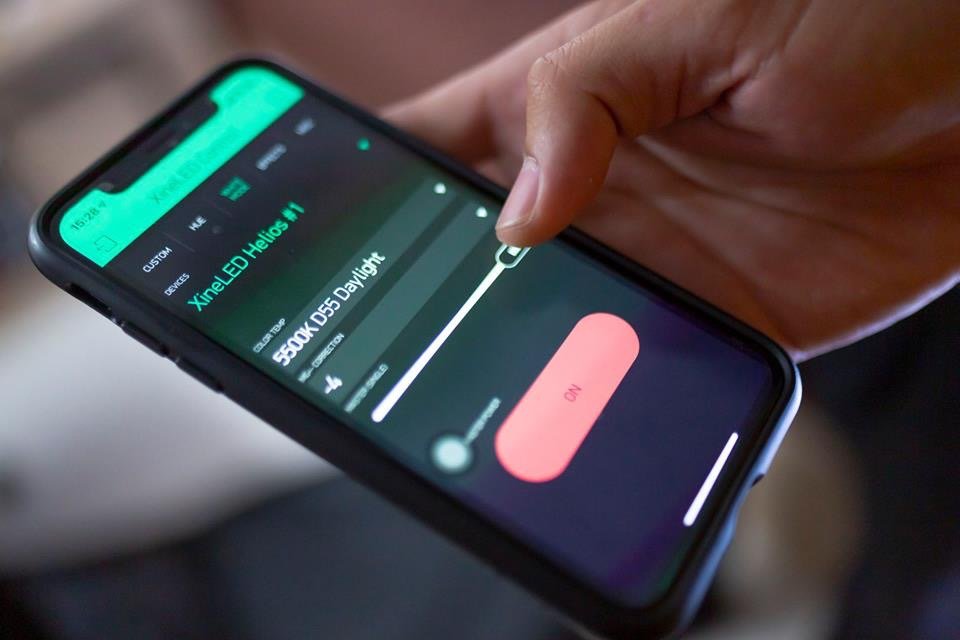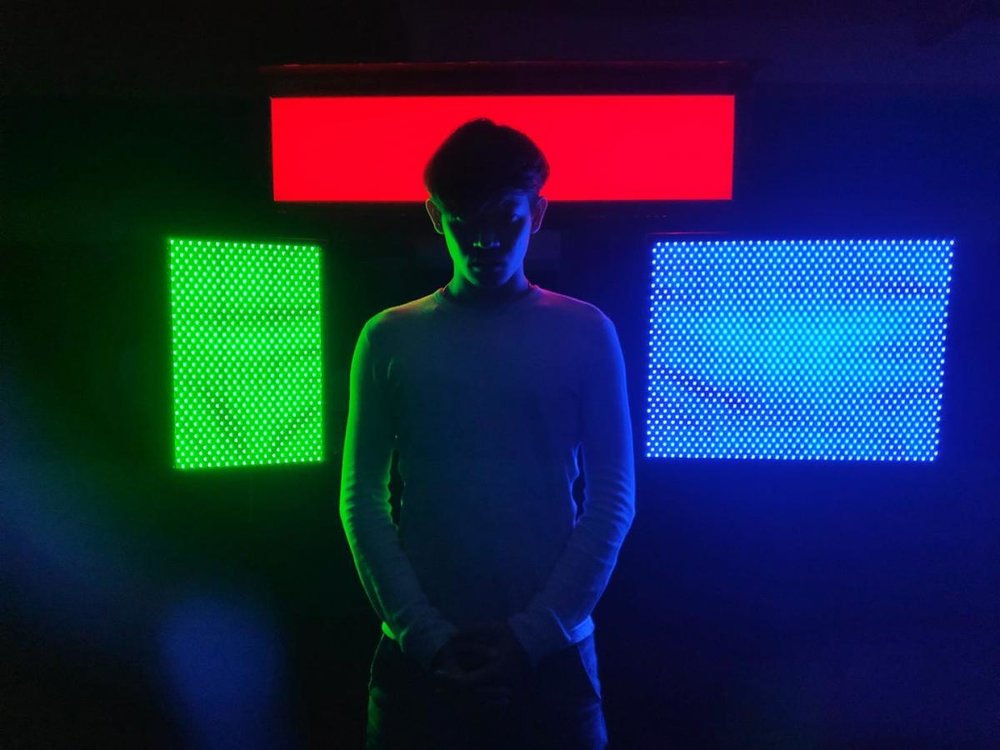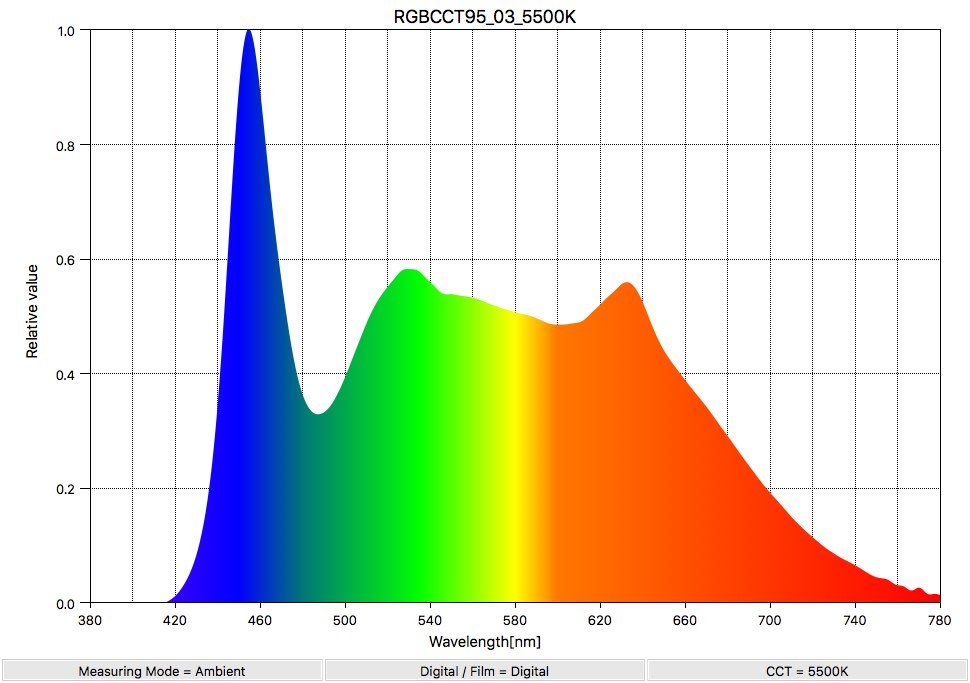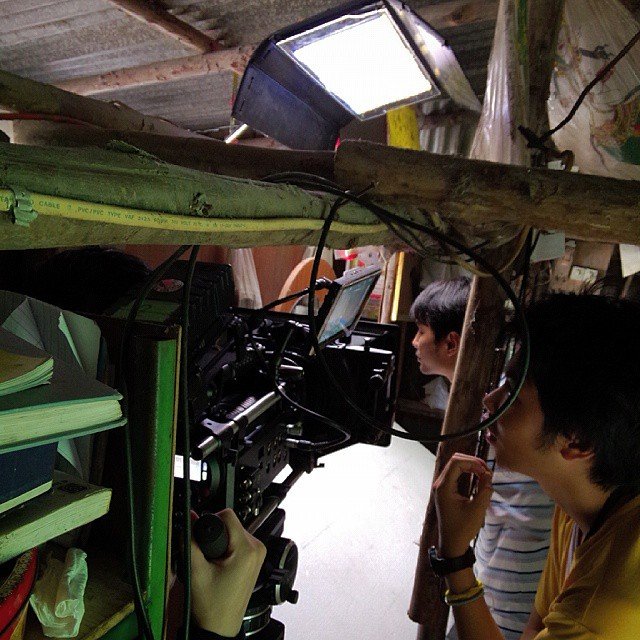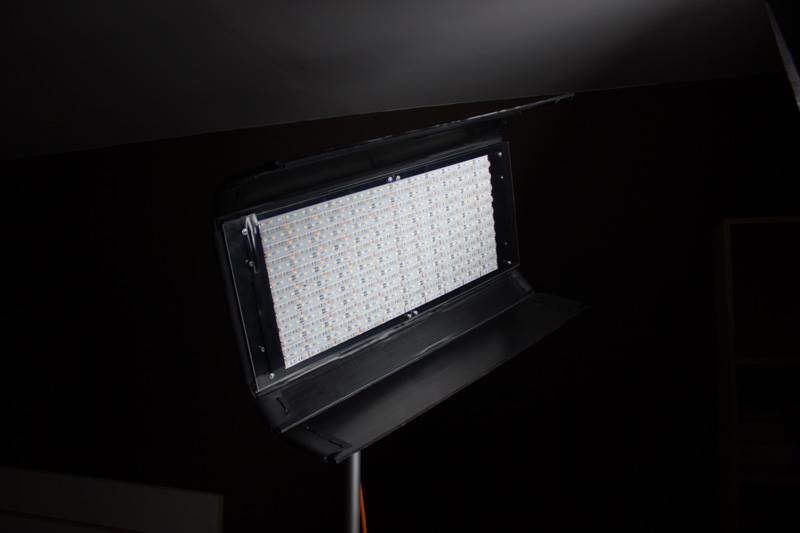-
Posts
43 -
Joined
-
Last visited
Everything posted by Chanon Wangtrirat
-
It introduced at the time that LED was not that mature, mediocre efficiency and less predictable color back then. I don’t surprise why Arri choose that route back then. It’s more predictable than most light there plus get function like changing color. So yeah it tuned toward alexa. it’s overdue for arri to come up with something better than skypanel(form) fixture. fact is Mike Wagner who do marketing for ARRI lighting moved to Litegear as CEO. Also my DIY panel already copy form of litemat for my usage because it’s so lightweight. BTW, i cant find SSI of skypanel. Could someone measured that?
-
Hi! I'm Thomas. After I used CRI to measure such thing so long ago with those flos now LEDs. I found these measurement of SSI, TLCI, TM-30 too complicated to evaluate light when you just want to buy one, It's too much data use to judge how good light is. True that SSI has been invented but we are too far from getting such technology like LED to get perfect score or even touch 85 in daylight without using UV chip instead of blue. Which mak SSI score look awkward especially when compare to conventional lightsource like HMI or tungsten. BTW SSI invented to use to match 2 lightsources not directly use to evaluated such light quality. It could be use but honestly look awkward to me. So I came up with something more simple of single number defined quality of light ALQI = Average Light Quality Index Simply calculated from - CRI : Ra, R9(red), R12(blue), R15(skintone) - SSI : measured with CIE CCT closest to lightsource you measure IE. 5600K (input color temperature on Sekonic C800) - TLCI Representing camera sensor. Just average 6 measurements and you will come up with ALQI 100 = Perfect < 70 : Severe Color shift < 80 : Some Color shift > 80 : Usable for most photographic task > 85 : Great for most photographic task > 90 : Excellent for most photographic task > 95 : Reference class match Here's some ALQI various sources from my own measurements and internet Direct Sunlight (Thailand) 9.40AM 5600K ALQI = 99.3 KinoFlo KF55 20W Fluorescent ALQI = 83.1 Incandescent 2700K ALQI = 99.3 5000K LED CRI98+ ALQI = 91.4 3000K CRI98 LED Chip ALQI = 93.4 Sylvania 3w 2700K generic household. ALQI = 65.5 MasterPor 5000K Light ALQI = 87.9 1W 3030 CRI98 LED Chip 6000K ALQI = 90.5 Nanlite Forza 60B 3200K ALQI = 87 Nanlite Forza 60B 5600K ALQI = 89.2 Nanlite Forza 200 5600K ALQI = 90.6 Fuji XT-20 Xenon Flash ALQI = 95.4 Luminus COB 300W 5600K ALQI = 88.5 Luminus COB 150W 3200KK ALQI = 87.1 Litepanel Gemini 1x1 5600K ALQI = 87.1 Litepanel Gemini 1x1 3200K ALQI = 88.3 Rayzr MC 400 MAX 3200K ALQI = 72.3 Rayzr MC 400 MAX 5600K ALQI = 86.8 Aputure NOVA P300c 3200K ALQI = 91.9 Aputure NOVA P300c 5600K ALQI = 92.2 If you have C-800 in your hand you can help me fill the table of such lightsources. Happy rigging!!!! Thomas
-

My Self made LED - KinoFlo Select style
Chanon Wangtrirat replied to Chanon Wangtrirat's topic in Lighting for Film & Video
The Original apollo is aging. There is some problem about connections between LED strips. Because it's diy project. There are new panels I made have same formfactor like litegear litemat. Which use aluminum sheet as structure have really clean surface for strip and adhesive to stick on. Use 5 colors RGB+CCT in 1 chip. Produced clean white from 2800K to 10000K same as before but has more consistant in brightness. Photo of my friend lit using Kino Flo KF55 on the right and new Apollo LT on the left. All using same control as before on Blynk with now running local server on NANOPI duo in powerbank. Not scared of no internet connection anymore. -

My Self made LED - KinoFlo Select style
Chanon Wangtrirat replied to Chanon Wangtrirat's topic in Lighting for Film & Video
The latest test pave for second panel I will made. Experiment for decision of strip. This is the most accurate combination I've done. RGB + White 6000K CRI 95 + Warm White 2850K CRI95. The most expensive one also. Achieve CRI Ra 96.7 Calibrated using Sekonic C-700 with MG+-0 @5500K -

My Self made LED - KinoFlo Select style
Chanon Wangtrirat replied to Chanon Wangtrirat's topic in Lighting for Film & Video
I used Meanwell 24V 400W Power Supply. Sightly under voltage to 22.7V lower the heat stress on panel. -

My Self made LED - KinoFlo Select style
Chanon Wangtrirat replied to Chanon Wangtrirat's topic in Lighting for Film & Video
Maybe but not for now as I have to test it myself first. -

My Self made LED - KinoFlo Select style
Chanon Wangtrirat replied to Chanon Wangtrirat's topic in Lighting for Film & Video
The Phosphor on warm white has stronger yellow-orange-red distribution which easily compliment by add blue spectrum by Blue LED and add more red by Red LED The Blue chip in white LED have so much power in itself opposed to red which is lower energy than blue. Red LEDs are also inefficient compared to blue. -

My Self made LED - KinoFlo Select style
Chanon Wangtrirat replied to Chanon Wangtrirat's topic in Lighting for Film & Video
Yes, Trial and error. Firstly, I use i1Pro2 spectrometer to measure the CRI CQS above. but later I borrow Sekonic C-700 for better evaluation. -

My Self made LED - KinoFlo Select style
Chanon Wangtrirat replied to Chanon Wangtrirat's topic in Lighting for Film & Video
Yes, more than 20000Hz. There is sightly banding occur in >1/400 shutter speed but most of the time I shot just 1/50-1/100 so it performed flawless even dim down to 5% -

My Self made LED - KinoFlo Select style
Chanon Wangtrirat replied to Chanon Wangtrirat's topic in Lighting for Film & Video
I used ledc function on esp32 which can be easily coded. Blynk virtual wire just send variable from slider on smartphone. ledcSetup(3, 12000, 12); // 12 kHz PWM, 12-bit resolution And then BLYNK_WRITE(V0) { PWM_LED1 = param.asInt(); ledcWrite(1, PWM_LED1); } This is example from others but my code runs at 13 bit resolution (8192 level) to control brightness. -
Hi! guys. I'm again on Lighting topic. Some of you might have read my post http://www.cinematography.com/index.php?showtopic=66862&do=findComment&comment=427134 That one was really old and now decommission for upgrade and refurbish with some exciting new feature that I got. I've made LED called : XineLED Apollo for evaluating LED to be use instead of Fluorescent in my arsenal. This one made from home depot softpanel LED troffer which you can. find in various size. Here is what I wonder to have - High CRI over 90-95 - Color Tunable - High brightness - Battery Powered - Large Aperture - Smart Function - No flicker dimming This have to be replace all LEDs inside the unit to new one which denser and have RGBW Strip. Nominal Power consumption : 280W Last time I posted the topic. I said, It would have to use CRI 95 LED for White LED to have best color rendition. WRONG!!!!! This is due to red primary which use in CRI 90-95 LEDs is really Red spectrum opposed to Orange-Red in normal YAG CRI 80 LEDs. Here's measurement I take with i1Pro2 Spectrophotometer with CRI CQS and various standard results. This is CRI 95 WarmWhite + CRI 86 Warmwhite (for Spectral continuity) + RGB This is Normal Panasonic 3W Warmwhite LED CRI 85 + RGB. The result is really clear. Main things need to go right with RGBW - White LED need to have continuous spectrum but being cut off at some spectral for RGB to add later - Blue LED in RGB LED have to fairly deep blue. Likely to cause Metamerism for both eyes and Camera sensor, Royal blue 460-470nm for optimum color rendition and light source match. - Controlling software need to be totally HSL color manage solution (for professional equipment) SKINTONE test with Standard Sony photo Tungsten 3200K mode I'm pleasedwith how it's render skintone. CONTROLLING : I use ESP32 for controlling the brightness in each channels, It's amazingly cheap but yet fully functional for me. Control using Blynk platform on Mobile phone. As I have no skill in writing code on OLED/LCD menu interface. DRAWBACK : Blynk application needs to connect to the internet. which make me have to turn on hotspot on phone when I use outside range of my home wifi. Here's current functions I've already written the code. White Mode (K) - 3200 - 4100 - 5000 - 5500 - 6000 - 6500 - 7500 - 8500 - 10000 This is preset being calibrated with both Spectrometer and camera sensor. (Canon, Sony) Effect lighting - Fire - Police - Lightning - Party fade RGBW custom mode All being control on smartphone. It also have small OELD Screen for status message. Many feature will be add later as I find out how to write the code ( i'm so noob on this.) Video just test on Hue mode UPDATE Coming !
-

My DIY Kino-Flo Select Style LED.
Chanon Wangtrirat replied to Chanon Wangtrirat's topic in Lighting for Film & Video
Oh! Thank you. Really cute little light with such tons of functions. I afraid that modding it to drive larger panel don't really work the way it should because it have to be calibrated. But at least I get some idea for the interface. ESP32 inside for sure. Yes. But not that easy. -

My DIY Kino-Flo Select Style LED.
Chanon Wangtrirat replied to Chanon Wangtrirat's topic in Lighting for Film & Video
The first resistor current limiting strip I used is here. https://www.aliexpress.com/item/Superbright-2835SMD-LED-22-24lm-led-2800-6500K-120leds-m-5m-per-reel-5mm-PCB-CRI/32673461159.html?spm=a2g0s.9042311.0.0.CX7hVw The Constant current I bought from here. https://www.aliexpress.com/item/5m-reel-DC22-27V-112-leds-m-2835SMD-High-CRI-90Ra-Constant-Current-IP20-non-Waterproof/32547434392.html?spm=a2g0s.9042311.0.0.CX7hVw I have already test the constant current one. 90' CRI LED. It's somewhat have little greenish tint to it. Which I think easier for me to correct with RGB LED, Green one have such poor power compare to blue or white LED. And the RGB I found here. But I haven't bought it yet. It just very new in market. http://www.addressable-led.com/Products/Constant-Current-RGB-LED-Strip.html There're some spec that I'm concern. The RGB one is the most serious one. The Apollo made out of RGB strip which have not deep enough blue LED. It's fall in light blue region. Made it after calibrate to the camera seem to be greenish on eyes. I will test one before purchase multi-meters for making another one. I have plan to buy C-700 for evaluation soon. for Scientific measurement. -
Hi! There I'm Thomas. In the past 2 years I have made Dive like LED fixture posted here http://www.cinematography.com/index.php?showtopic=66862&do=findComment&comment=427134 It's made out of Off-shelf LED strip contained Horrible warm-white LED and RGB LED. The output is low because I have to use Red LED to correct there poor color rendition to such just usable but it's very versatile and fast to use because of RGBW type ability to change color. As it is made before any of Celeb or Skypanel debut at that time. I can see the potential of this kind of fixture features. Now it's 2017. The High CRI LED comes surprisingly cheap. All LED products are freaking cheap. This is XineLED Apollo I named it because it's pretty bright. Consumed 288w (opposed to Skypanel nominal 400w I won't going to fight). It brighter even 4x4 bank and most of Celeb and Select. It's Light head + PSU 360W from Meanwell 24V I use Arduino DUE to control the intensities of multiple channels, RGBW. the Arduino DUE can control PWM modulation in 12bit resolution at 20KHz which plenty of room to prevent the flicker problem. It may cause some trouble with High-speed more than 300fps but hey! 288w won't suite for that job right? 12 bit pwm dimming means precise control of intensity up to 0-4095 level of brightness. I write the code which set the white balance in 12bit of 4 channels and then rotary encoder will feed the dimming level and calculate level output each channel should lit. So it's more precise than 8bit 0-255. But this is for internal calculation only. The Code is not fully complete I just barely use just 5500K preset as I can't write the menu system for LED/OLED yet. I will hire someone to program it. The Panel consists of 30m of LED Strip ( 15m for Warm-white and 15m for RGB). The housing made of plastic and aluminum bezel with Very good quality diffuser It's all from Troffer LED panel which I bough from home depot here in Thailand. one with LED at the back of it not the edge. Then I removed all crap original LEDs. I planned to go for Constant current version of strip soon because normal one use resistor to drive the chip, It's inefficient. Here some pics from testing it on bench. Housing finished the side with durable plastic document folder and big cable tiles. It's pretty durable. Flexible conduit I used large copper cable instead. Some scene put to use with 3200K preset (just write analogwrite code on arduino). Aquablue with few lines of code make straightout sci-fi look. Here is short video test the Magic lantern RAW at 3K featured XineLED Apollo in the room with Aqua blue. It's ability tune the color because it's RGBW. Thanks for all comments. I would love to see your appreciation.
-

Testing out my DIY RGBW LED panel on set.
Chanon Wangtrirat replied to Chanon Wangtrirat's topic in Lighting for Film & Video
I have experiment with Arduino Mega which can drive at 32KHz which produced no flicker at all within 1/2000. It's now being develop with Digital circuit. It may get more efficient than old circuit which used current limiting transistor. -
Last time I posted Just made my self LED fixture. Tuneable, Color lighting. http://www.cinematography.com/index.php?showtopic=65114 The photo in post broken link. I just have opportunity to really testing it in real set and with professional camera like RED One ( really the first RED One sir!!) The power get cut on that day and I can't use any Kinos. So interior is very tight space and mostly closed. Reflector was use to bounce the light from outside through the door right side and left of female actor. I put LED on C-stand and get it above actor to simulate windows light from above which tend to get warmer because it mostly will get yellow tint. So I adjust it to 5300K preset. Power? it was tap from RED v mount battery. It's RGB ribbon + WW LEDs ribbon mixed together and calibrated on histogram, vector scope and some eye on Magic Lantern. I installed micro prism sheet which similar to Litepanel Nanopticlens used on Helios line directing the light to 60 degree. Here are samples screenshot Here LED was lit from above the man. There are a lot to be done with it. It's consume too much power supposed that because it's RGBW and not efficient LED chip. But hence it's RGBW it have much flexibility as it design to use.
-
This is really interesting. The idea to program Arduino to control DMX 512 on this module. http://www.aliexpress.com/item/Free-Shipping-Hot-Sale-RGBW-DMX-Decoder-4CH-DMX512-LED-Driver-RGBW-Controller-DE-8015/1409426007.html They said it's PWM at 5KHz which is pretty nice for normal shutter speed or even high speed that don't exceed 1/5000 (maybe) I will be order one to try it. Here is some test from youtube. http://www.youtube.com/watch?v=ixfHxOnGJPI
- 11 replies
-
- xineled600
- led
-
(and 3 more)
Tagged with:
-
Exactly a problem I am facing too. I wonder how those LEDs in the market that have digitised control system doing with controlling the power. Find it at cheapest method is the hardest thing.
- 11 replies
-
- xineled600
- led
-
(and 3 more)
Tagged with:
-
I think I can remember it. - 5M of RGB Ribbon. (But I think 5m x2 will be better as it has to be fighting against WW LEDS intensity.) - 5M of WW Ribbon or hard rigid WW LEDs. (If you can find one with higher color rendering it will be lower for RGB to correct color.) - 5mm Corrugated board similar to Diva-lite. (I think double the RGB LEDs will take some more space than I did.) - 7A 12v PSU - AC cord. (or using power brick. As mine is integrated into back of the unit already.) - Plexiglass I used 1x1ft 2 pcs to make front protection. - MDF as backplate to reinforced the structure. - Aluminium box (I used as a main structure to attach to light stand adaptor made from Flash stand mount. All electronic are enclosed in here.) - Some nots, washers and screws. Electronic part. You can use DC-DC Buck converter for 4 of them which provided more precise adjustment or simple transistor dimmer circuit. My unit consist of - 4 knob and potentiometers. - 8x 13007 NPN transistor - 4 Positions selector switch. - 13 trimpots for 4 presets. 3 for each RGB channel x4 and 1 for WW LEDs at constant intensity throughout 4 presets. - 4 Relays for switching between Preset and Custom. - 2 jog switch for on/off and preset. this is totally depends on part and method to control light output. I will do second unit soon which will double the RGB ribbons to increase intensity to fight WW LEDs. Arduino just arrived today maybe I can do something with it. Notice : The LED dimmer on the eBay and most market today is PWM dimming circuit. Which cause flickering on the camera even at 1/50 shutter speed because it's not operate on any of household frequency at all. The buck DC-DC converter is the way to go for now. Using this complex method to achieve white light. On the other hand Arri L7-C have micro processor that monitoring and calibrate the light color output. My Diy light have to be monitor and calibrated the trimpot for optimum white light accuracy. This is totally have to take care some. But if you do right you will be happy with the result.
- 11 replies
-
- xineled600
- led
-
(and 3 more)
Tagged with:
-
Yes, Blue LED is the game changer. We can't walk to this point if there is no Blue LED!!!! Another technology that I think it's innovative is the UV violet LEDs. Manufacturer called Yuji Beiling international make this. Instead of Blue chip excited phosphor to make white light. They used Violet UV LED to excited Red-Green-Blue phosphor resulting in more controlled color spectral output. . http://www.yujiintl.com/high-tlci-led I have called them and guess what???? one of the customer of them is Kino-Flo. Using there LED to make Celeb LED light. As seen in Kino-Flo Celeb video For now I can't effort to buy those LEDs. It's too expensive to make just this one but I think if it made up. With CRI and TLCI up to 97. Ridiculously excellent color rendition. They make conventional 5mm LED used on Litepanel 1X1 but with Blue LED CRI up to 90 too. Also Ribbon 5050 LEDs with High CRI / TLCI Violet Chip LEDs.
- 11 replies
-
- xineled600
- led
-
(and 3 more)
Tagged with:



